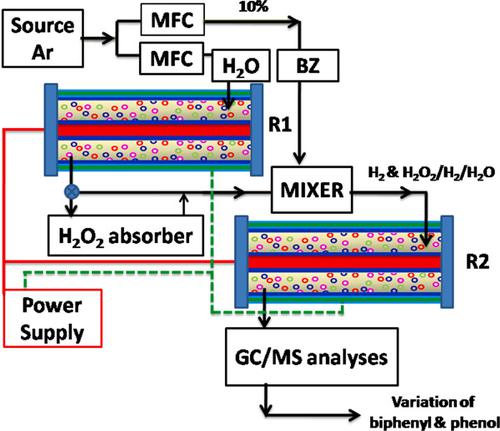当前位置:
X-MOL 学术
›
Plasma Processes Polym.
›
论文详情
Our official English website, www.x-mol.net, welcomes your
feedback! (Note: you will need to create a separate account there.)
Benzene transformation in two dielectric barrier discharge reactors having special arrangement
Plasma Processes and Polymers ( IF 2.9 ) Pub Date : 2019-09-23 , DOI: 10.1002/ppap.201900065 Ghasiram Dey 1
Plasma Processes and Polymers ( IF 2.9 ) Pub Date : 2019-09-23 , DOI: 10.1002/ppap.201900065 Ghasiram Dey 1
Affiliation

|
Argon–benzene (Ar–Bz) gas phase plasma chemistry work is explored for benzene transformation employing the dielectric barrier discharge (DBD) cold plasma technique. To do so, experiments are carried out with two identical coaxial DBD reactors in serial‐type arrangements. The first carries moist Ar having 100% relative humidity (90% of total Ar flowing over water) and its outlet is mixed with Bz, which is saturated in the remaining 10% Ar at the inlet of the second reactor before plasma generation. This type of arrangement perhaps favors Bz transformation significantly for explicit products because the H2 generated in the first reactor as one of the major in situ products in the Ar‐moisture DBD system might facilitate chemical reduction of Bz to biphenyl in the second reactor during DBD. Conversely, H2O2, another product in Ar‐moisture discharge, enhances the yields of phenol. DBD outlet products, such as methane and leftover Bz, are analyzed and estimated with online gas chromatograph–flame ionization detector analysis, whereas H2 is analyzed with gas chromatograph–thermal conductivity detector. Additionally, the offline gas chromatograph–mass spectrometer analysis of acetone solutions of surface deposits obtained after discharge reveals the formation of phenol and biphenyl along with other products. The periodically analyzed data reveal that the generation of phenol, biphenyl, and CH4 relate directly to discharge duration and input moisture concentration.
中文翻译:

两个具有特殊布置的介质阻挡放电反应器中的苯转化
利用介电势垒放电(DBD)冷等离子体技术探索了氩-苯(Ar-Bz)气相等离子体化学工作,以进行苯转化。为此,我们对两个相同的同轴DBD反应器进行了串联式布置实验。第一个载有相对湿度为100%的湿Ar(流过水的总Ar的90%),其出口与Bz混合,Bz在等离子产生之前在第二个反应器的入口处的其余10%Ar中饱和。这种安排可能显着地促进了显性产物的Bz转化,因为在第一反应器中生成的H 2作为Ar-水分DBD系统中的主要原位产物之一,可能有助于在DBD期间将第二反应器中的Bz化学还原为联苯。反之,H2 O 2,另一个具有Ar水分排放功能的产品,可以提高苯酚的收率。DBD出口产品(例如甲烷和剩余的Bz)通过在线气相色谱仪-火焰电离检测器分析进行分析和估算,而H 2则通过气相色谱仪-热导率检测器进行分析。此外,脱机后获得的表面沉积物的丙酮溶液的离线气相色谱-质谱分析表明,苯酚和联苯与其他产物一起形成。定期分析的数据表明,苯酚,联苯和CH 4的产生与放电持续时间和输入的水分浓度直接相关。
更新日期:2019-09-23
中文翻译:

两个具有特殊布置的介质阻挡放电反应器中的苯转化
利用介电势垒放电(DBD)冷等离子体技术探索了氩-苯(Ar-Bz)气相等离子体化学工作,以进行苯转化。为此,我们对两个相同的同轴DBD反应器进行了串联式布置实验。第一个载有相对湿度为100%的湿Ar(流过水的总Ar的90%),其出口与Bz混合,Bz在等离子产生之前在第二个反应器的入口处的其余10%Ar中饱和。这种安排可能显着地促进了显性产物的Bz转化,因为在第一反应器中生成的H 2作为Ar-水分DBD系统中的主要原位产物之一,可能有助于在DBD期间将第二反应器中的Bz化学还原为联苯。反之,H2 O 2,另一个具有Ar水分排放功能的产品,可以提高苯酚的收率。DBD出口产品(例如甲烷和剩余的Bz)通过在线气相色谱仪-火焰电离检测器分析进行分析和估算,而H 2则通过气相色谱仪-热导率检测器进行分析。此外,脱机后获得的表面沉积物的丙酮溶液的离线气相色谱-质谱分析表明,苯酚和联苯与其他产物一起形成。定期分析的数据表明,苯酚,联苯和CH 4的产生与放电持续时间和输入的水分浓度直接相关。











































 京公网安备 11010802027423号
京公网安备 11010802027423号